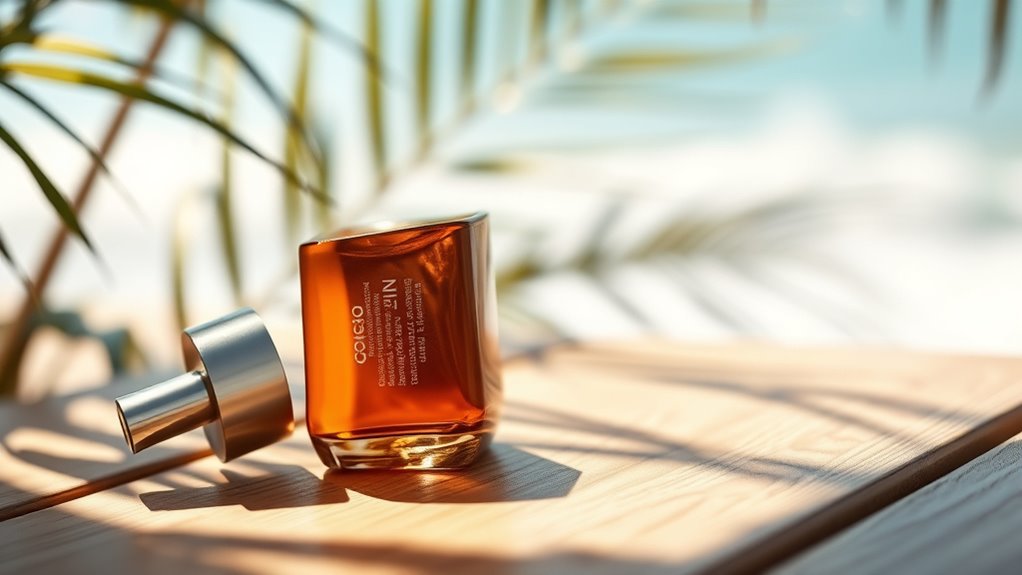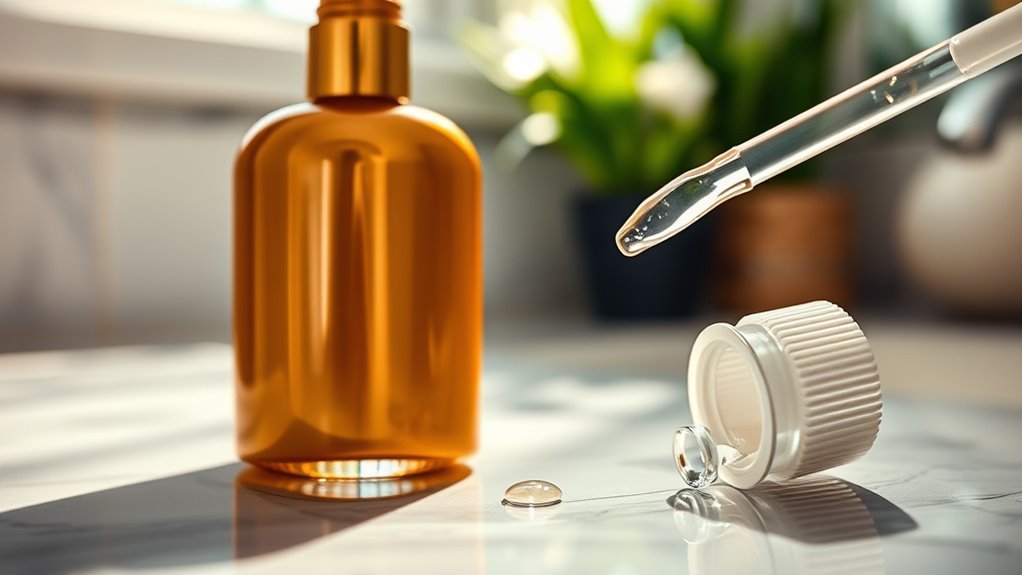Self-tanning lotions are generally safe because they use dihydroxyacetone (DHA), which reacts with your skin’s outer layer to give a natural-looking tan. DHA is approved and doesn’t involve UV exposure or penetrate deep into your skin. However, some people with sensitive skin may experience irritation or allergies. To stay safe, test products first and follow application instructions carefully. Want to understand more about DHA’s safety and best practices? Keep exploring to stay informed.
Key Takeaways
- DHA in self-tanners reacts with skin’s outer layer to produce a natural-looking tan, without UV exposure.
- DHA-based products are generally safe, but may cause mild skin irritation or allergic reactions in sensitive individuals.
- Conduct a patch test 24 hours before full application and follow usage instructions to minimize adverse effects.
- Self-tanners do not provide UV protection; always use sunscreen when exposed to sunlight.
- Avoid applying on broken or irritated skin and choose fragrance-free, gentle formulations for sensitive skin.

Self-tanning lotions offer a convenient way to achieve a sun-kissed glow without exposing your skin to harmful UV rays. This means you can enjoy a bronzed look without risking premature aging, sunburns, or skin cancer linked to UV exposure. However, it’s vital to understand how these products work and what potential skin reactions you might encounter. Most self-tanning lotions contain dihydroxyacetone (DHA), a colorless sugar that reacts with the amino acids in the outer skin layer to produce a brownish pigment. This reaction is generally safe and has been approved by regulatory agencies, but it’s natural to wonder if it’s entirely risk-free.
When you apply a self-tanning lotion, you’re fundamentally encouraging a chemical reaction on your skin’s surface, which doesn’t involve UV rays. Unlike tanning from sunlight or tanning beds, which increase the risk of UV exposure, DHA-based products don’t penetrate deep into your skin or damage your DNA. That’s part of what makes them a safer alternative. Still, it’s vital to monitor how your skin reacts after application. Some people experience skin reactions such as redness, dryness, or irritation, especially if they have sensitive skin or allergies to certain ingredients. These reactions are usually mild and temporary but can sometimes be more severe if you have a history of skin allergies or dermatitis.
To minimize the risk of skin reactions, always do a patch test before fully applying a self-tanning lotion. Apply a small amount on a discreet area, like behind your ear or on your inner arm, and wait 24 hours to see if any irritation develops. If you notice redness, itching, or swelling, avoid using that product altogether. It’s also wise to follow the instructions carefully—exfoliating your skin beforehand ensures an even application, and applying the product evenly prevents streaks or uneven coloration. Wearing gloves can help avoid staining your hands and reduce the chance of accidental skin reactions on your palms.
While DHA itself is considered safe for topical use, some formulations contain additional ingredients that could cause sensitivities. Look for products free of fragrances, alcohol, or other potential irritants if you have sensitive skin. Remember, self-tanning lotions don’t offer protection against UV exposure, so they shouldn’t be an alternative to sunscreen when you’re outdoors. Even if your skin looks tanned, you’re still vulnerable to UV rays, which can cause skin damage over time. Moreover, ongoing research on cosmetic ingredients continues to assess their safety profiles, ensuring products remain safe for consumer use. To conclude, self-tanning lotions are generally safe when used correctly, but staying aware of possible skin reactions and following safety tips helps guarantee you enjoy your bronzed glow without unnecessary risks.
Frequently Asked Questions
Can Self-Tanners Cause Allergic Reactions?
You might wonder if self-tanners can cause allergic reactions. It’s possible because ingredient safety varies; some people are sensitive to ingredients like DHA. To reduce risks, do a patch test before full application and follow application tips carefully. Wearing gloves during application can also help prevent skin irritation. If you notice redness or itching, wash the area immediately and avoid using the product again.
Are There Long-Term Health Effects of DHA Exposure?
Like whispers from the past echoing through time, concerns about DHA’s long-term impacts linger. While skin absorption of DHA is minimal and deemed safe for short-term use, the long-term impacts remain less clear. Ongoing research suggests that occasional exposure isn’t likely to cause harm, but continuous, high-level use might pose risks. It’s wise to enjoy your glow mindfully, staying informed about emerging studies on DHA’s long-term health effects.
How Does DHA Interact With Skin Conditions?
When DHA interacts with your skin, especially if you have skin sensitivity or conditions like eczema, it can cause irritation or redness through topical application. People with sensitive skin should test a small area first to watch for adverse reactions. DHA reacts with dead skin cells, which might worsen some skin conditions temporarily. Always consult a dermatologist if you’re unsure, and choose products formulated for sensitive skin to minimize risks.
Is DHA Safe During Pregnancy or Breastfeeding?
Did you know over 80% of pregnant women worry about skincare safety? During pregnancy safety and breastfeeding concerns, using self-tanning lotions with DHA is generally regarded as safe because DHA only interacts with the skin’s surface, not the bloodstream. However, it’s best to consult your healthcare provider first, especially if you have sensitive skin or allergies, to ensure you protect both you and your baby.
Can DHA Be Absorbed Through the Skin Into the Bloodstream?
You might wonder if DHA skin absorption leads to bloodstream penetration. Research shows that DHA primarily reacts with the skin’s outer layer, forming a tan without significant absorption into the bloodstream. While some minimal DHA skin absorption occurs, it doesn’t usually reach systemic circulation. So, you can feel more confident using self-tanning lotions, knowing that DHA’s bloodstream penetration is limited and unlikely to affect your overall health.
Conclusion
Overall, self-tanning lotions are like a double-edged sword—you get that sun-kissed glow without the sun’s harmful rays, but you should still handle them with care. When used correctly, they’re generally safe and your skin’s best friend in a tanning emergency. Just remember to follow the instructions, do a patch test, and keep your skin hydrated. Think of it as painting your perfect summer look—just handle the brush with care, and you’ll shine safely.









